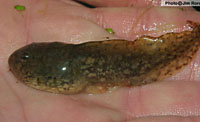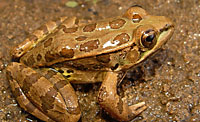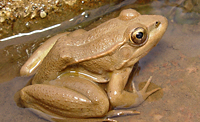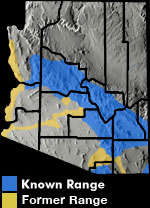Online Field Guide to The Reptiles and Amphibians of Arizona


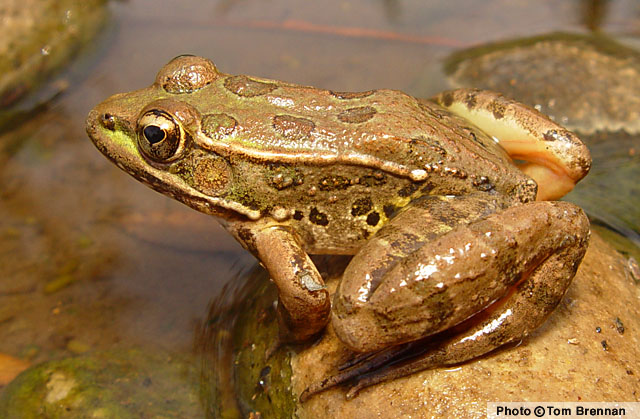
Gila County, AZ
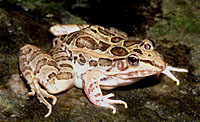 Gila Co., AZ |
||
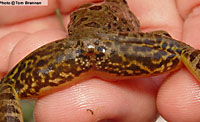 Thigh pattern. Gila Co., AZ |
| LOWLAND LEOPARD FROG Lithobates yavapaiensis | |
|
DESCRIPTION: The lowland leopard frog is a relatively small leopard frog – maximum length is about 3.4 inches. It is distinguished from other Arizona leopard frogs by a combination of characters, including dorsolateral folds that are broken and inset towards the rear, a dark brown and tight reticulate pattern on the rear of the thigh, and usually no spots on the snout. Adult males lack prominent vocal sacs. This is typically a brown frog, although some are green, particularly on the head. There is often a yellowish wash to the groin area. Compared to other leopard frogs, the tadpoles are relatively dark, mottled, and stocky. They are similar to Chiricahua leopard frog tadpoles, but browner with a shallower tail. Tadpoles grow to > 3 inches. The lowland leopard frog is very similar to the relict leopard frog; the two may be the same species. DISTRIBUTION: The lowland leopard frog occurred historically from the lower Colorado River east through central Arizona below the Mogollon Rim and southeastern Arizona to New Mexico. The species is now absent from the lower Colorado River and adjacent portions of southeastern California, they are about gone from their limited historical range in New Mexico, and have declined significantly in southeastern Arizona. Although no records exist for the lower Gila River downstream of the Phoenix area, they almost certainly occurred there historically, but are now replaced by the Rio Grande leopard frog and bullfrog. The species is still relatively secure in central Arizona; however, declines and extirpations have occurred in that region as well. HABITAT: This frog currently or historically inhabited big rivers, streams, ciénegas, cattle tanks, agricultural canals and ditches, mine adits, and other aquatic systems from the Yuma Valley at near sea level to almost 6,000 feet, and from Sonoran Desertscrub into pinyon-juniper woodland. Lowland leopard frogs do well in unregulated streams that are subject to periodic floods. BEHAVIOR: Can be found active day or night, although they are easier to find and observe at night with a headlamp or flashlight. Moves overland and along drainages during summer monsoons. Active nearly year-round in the desert. DIET: The lowland leopard frog presumably feeds upon a wide variety of invertebrates as well as some small vertebrates. REPRODUCTION AND CALLS: Breeds primarily from January through April, and again in late summer or early fall. Egg masses are laid in shallow water and are attached to vegetation, bedrock, or gravel. Tadpoles take 3-9 months to metamorphose, and some overwinter. Adult males give a distinctive advertisement call consisting of a series of chuckles that are not very loud and are similar to that of the Plains and relict leopard frogs. REMARKS: Causes of decline include predation by a number of non-native species, catastrophic flooding and scouring following severe fires, other loss and alteration of habitats; and chytridiomycosis – a fungal skin disease. However, the lowland leopard frog is able to coexist with invasive exotic species better than the Chiricahua leopard frog, probably because it can breed in relatively shallow, flowing water that is marginal habitat for exotics. By Jim Rorabaugh PROTECTED Davidson, C. 1996. Frog and toad calls of the Rocky Mountains. Library of Natural Sounds, Cornell Laboratory of Ornithology, Ithaca, NY and USDA Forest Service. Sartorius, S.S., and P.C. Rosen. 2000. Breeding phenology of the lowland leopard frog (Rana yavapaiensis): Implications for conservation and ecology. The Southwestern Naturalist 45(3):267-273. Sredl, M.J. 2005. Rana yavapaiensis Platz and Frost, 1984. Lowland leopard frog. Pages 596-599 in M.J. Lannoo (ed), Amphibian Declines: The Conservation Status of United States Species. University of California Press, Berkeley. |
|
Visit Partners in Amphibian and Reptile Conservation:


HOME
Copyright © 2023, Arizona Game and Fish Department. All rights reserved.
If you make use of the textual contents of this site in reports, publications, etc. please cite and credit the author(s) and photographer(s). All photos on this website are copyrighted. However, those found in the species account section may be used for any noncommercial scientific, educational, or conservation purposes provided that photographs are not altered and continue to bear the copyright symbol and name of the photographer. Please contact the photographer regarding commercial use of copyrighted photographs.










